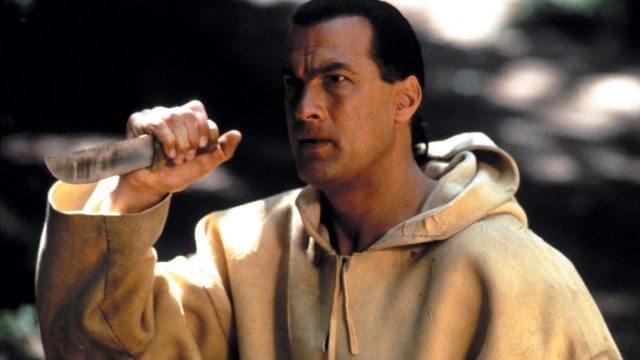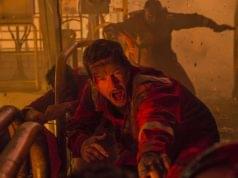
When the subject of Steven Seagal trivia comes up — and one could argue that all Seagal-related matters qualify as “trivia” — even a beginner knows the basics. His first film was “Above the Law”; he was married to Kelly LeBrock for a while; as the result of a gypsy curse his ponytail is the source of his power and he will die if it is ever cut off; etc. All of this is common knowledge. But do you know what film Seagal starred in that he also directed? I will tell you: “On Deadly Ground.”
Even if you have seen every movie in the Seagal canon, you might not remember which one “On Deadly Ground” is, since the titles of all his films are interchangeable and have no relation to their stories. “Hard to Kill,” “Marked for Death,” “Out for Justice,” “Under Siege,” “Exit Wounds,” “Half Past Dead” — which is which? I suspect there is a master list of generic titles somewhere, and whenever Seagal makes a new film (to play only in Korean cinemas or on American DVDs, of course) they just pull the next one off the list. Coming soon: “Furious Justice,” “Killing for Death,” “Revenge by Murder,” and “Deadly Murder Justice.”
“On Deadly Ground” is the Seagal movie where in addition to shooting people and blowing things up he also preaches about environmentalism. Seagal was at the high point of his career at this time, and he knew that if his fans loved high-octane action sequences they would also enjoy self-congratulatory activism. The Earth is very important to Seagal; as a Buddhist, he believes in the sanctity of all living things. Except in cases where the living things are people standing in front of his gun. Those living things need to be murdered.
Seagal plays Forrest Taft, a man whose special skills have made him a legend in the oil fields of Alaska. I do not know what these special skills are, but the people in the movie seem to. We first meet him at the scene of an oil-well fire, where he arrives via helicopter to the great relief of everyone present. “Thank goodness, Forrest is here!” they say. He examines the fire up close, which requires no particular skill other than covering your face so you don’t inhale smoke, and then pushes a button that detonates the explosives that have already been placed around the well, which requires no particular skill other than being able to push a button. The explosion puts out the fire. Wikipedia tells me that this is indeed how one extinguishes a fire at an oil well: you set off an explosion that rapidly consumes all the nearby oxygen and thus snuffs out the flame. The movie makes no attempt to explain this, so I’ll assume everyone except me already knew the ins and outs of oil-well firefighting. Perhaps everyone except me also knows why Forrest’s skills as a fire-observer and button-pusher are in such high demand.
The foreman on the job, Forrest’s old friend Hugh (Richard Hamilton), says the fire was started because the owner of the well was cutting corners on equipment costs. The oilman in question is Forrest’s boss, Michael Jennings (Michael Caine), a wealthy and conniving industrialist who wants to suck every last drop of oil out of Alaska even if it kills every animal and Eskimo in the state. Heck, ESPECIALLY if. Despite working directly for Jennings, Forrest never realized until now that his boss was evil. It comes as quite a shock, which is registered on Seagal’s face in the form of a dour squint that is not to be confused with the dour squints that represent his other emotions.
Having so far been called upon only to push a button, Seagal next takes us to a scene that permits him to beat people up. It’s a bar in whatever Alaskan town is nearby, where the oil workers mingle uneasily with the local Native Americans. One of the oil guys is a jerk who picks on a drunk Eskimo, which naturally requires Forrest to beat up not just the jerk but all of his jerk friends, too. When he’s done, he asks the jerk, all Zen-like: “What does it take to change the essence of a man?” The jerk sees the wisdom in this, and there are no hard feelings. Just as in real life, violence has solved the problem and led to greater peace among men.
Back at oil company headquarters, Jennings and his right-hand man, MacGruder (John C. McGinley), figure out that Hugh and Forrest know they’re breaking the law in order to get their new rig up and running on schedule. Eager to prevent any whistle-blowing, Jennings has Hugh killed and then attempts to kill Forrest by luring him into an oil well rigged with explosives. Yes, setting off explosives saved the day earlier, but this time it’s a bad thing. It’s the bad kind of explosives, the kind you use in plots to kill whistle-blowers.
Forrest doesn’t die, obviously. He is nursed back to health by some Eskimos who take him on one of those “spirit quest” things where he sees nude Indian women and swims in a river and stuff. He and the chief’s daughter, Masu (Joan Chen), become partners in stopping Jennings, though I will tell you right now that Masu doesn’t do a single thing for the rest of the film other than run alongside Forrest and try not to get killed. Instead of wasting the lovely Joan Chen, Seagal might just as well have cast a puppy.
Jennings surmises that Forrest is not dead, expending a lot of words to tell MacGruder (and us) just how deadly and powerful Forrest is. Thirty percent of the film’s dialogue is devoted to this topic. “He’s the patron saint of the impossible!” is something Jennings says. He’s a nightmare! He’s indestructible! He’s a one-man wrecking crew! He’s Batman, Rambo, and Jack Bauer rolled into one! Blah blah blah! You know a movie lacks self-esteem when it feels like it has to keep telling you how awesome its main character is. To kill the unkillable Forrest, now on the loose in the wilds of Alaska and planning to sabotage Jennings’ operation, Jennings hires a mercenary named Stone, played by R. Lee Ermey, better known as the Guy Who Always Plays the Loud Army Guy Who Yells at Everyone. If G.W.A.P.T.L.A.G.W.Y.A.E can’t find and kill Forrest, no one can! (Spoiler alert: No one can.)
Well aware that Stone and his team are on his trail, Forrest plots to kill them. First he rigs a shack with explosives, which he detonates as a helicopter approaches. Forrest, 20 feet away, jumps easily to safety ahead of the blast, while the helicopter, a good 50 feet off, explodes before the flames even reach it, apparently terrified into combustion at the mere thought of catching fire. That is how scary Forrest is.
He finally realizes he’ll need to blow up Jennings’ fancy new oil rig and refinery, too. He tells Masu, “It’s like I always say, we gotta blow it, and we gotta blow it now.” Really, Forrest? You ALWAYS say that? Actually, given how prominently explosions figure into most of his plans, it’s probably true. He probably really does always say that.
Blowing up the oil refinery means sneaking into the facility and murdering a lot of innocent security guards and low-level employees, including one that he shoots in the face. Doesn’t try to knock him out or incapacitate him or distract him; just shoots him in the face. It’s worth it, though, ending the lives of numerous people tangentially related to a dishonest businessman, if it saves just one seal from being poisoned by an oil spill.
It turns out Forrest’s beef isn’t just with Jennings but with the oil industry in general. Of course, he’s been working for the oil industry for years, but apparently now he hates it. Apparently he came to this realization at some point when we weren’t looking. Maybe one of those squinty faces he made somewhere in the middle was supposed to signify that. After the film’s climax, where all the bad guys are killed (along with their tertiary employees, the receptionists, and the H.R. department), Seagal tacks on a lengthy speech in which Forrest lectures a room full of legislators and Eskimos on the evils of Big Oil and the importance of alternative fuels. The fact that he makes an excellent point about the necessity of finding clean, renewable energy sources doesn’t diminish the fact that he sounds like a smug d-bag while making it. But hey, you can do whatever you want when you’re Steven Seagal, especially when you’re Steven Seagal and you’re also the director.
— Film.com





